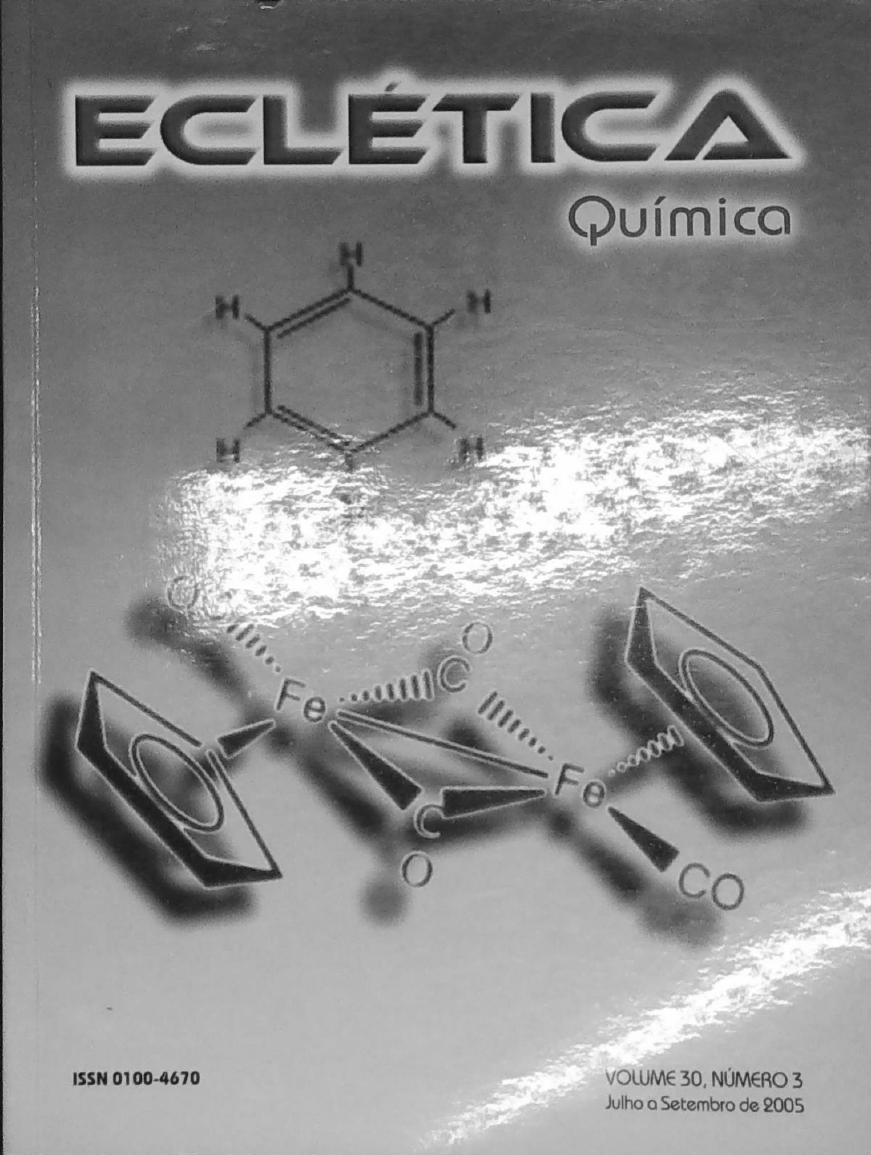Abstract
The possibility of using thiocyanate to determine iron(II) and/or iron(III) in water-acetone mixture
has been re-examined as part of a systematic and comparative study involving metallic complexes of
pseudohalide ligands. Some parameters that affect the complete oxidation of the ferrous cations, their
subsequent complexation and the system stability have been studied to optimize the experimental conditions.
Our results show the viability and potentiality of this simply methodology as an alternative analytical procedure
to determine iron cations with high sensitivity, precision and accuracy. Studies on the calibration, stability,
precision, and effect of various different ions have been carried out by using absorbance values measured at
480 nm. The analytical curve for the total iron determination obeys Beer’s law (r = 0.9993), showing a higher
sensitivity (molar absorptivity of 2.10x10 4 L cm -1 mol -1 ) when compared with other traditional systems (ligands)
or even with the “similar” azide ion [1.53x10 4 L cm -1 mol -1 , for iron–III/azide complexes, in 70% (v/v)
tetrahydrofuran/water, at 396 nm]. Under such optimized experimental conditions, it is possible to determine
iron in the concentration range from 0.5 to 2 ppm (15-65% T for older equipments, quartz cells of 1.00 cm).
References
G. O. Chierice, E. A. Neves, Polyhedron, 2 (1983) 31.
E. A. Neves, J. F. Andrade, Polyhedron, 5 (1986) 717.
N. Coichev, E. A. Neves, Polyhedron, 8 (1989) 641.
J. F. Andrade, O. M. Guimarães, Anal. Chim. Acta, 271
(1993) 149.
E. A. Neves, J. F. Andrade, G. O. Chierice, Anal. Chim.
Acta, 155 (1983) 269.
E. A. Neves, J. F. Andrade, G. O. Chierice, Anal. Lett., 18
(1985) 707.
R. Luca, J. E. Bevilácqua, E. A. Neves, J. F. Andrade,
Anal. Lett., 20 (1987) 389.
O. M. Guimarães, J. F. Andrade, E. A. Neves, G. O.,
Chierice, Anal. Lett., 26 (1993) 2491.
D. R. Carmo, J. F. Andrade, O. M. Guimarães, Anal. Lett.,
(1995)1897.
L. M. Lourenço, Estudo espectrofotométrico do sistema
crômio (III)/azoteto e seu aproveitamento analítico. 2003.
f. Dissertação (Mestrado em Química) - FFCLRP,
Universidade de São Paulo, Ribeirão Preto / SP.
A.P.O. Sader, Estudo espectrofotométrico do sistema
cobalto (II)/tiocianato e seu aproveitamento analítico. 2002.
f. Dissertação (Mestrado em Química) - FFCLRP,
Universidade de São Paulo, Ribeirão Preto / SP.
C. J. Chacarolli, J. F. Andrade, O. M. Guimarães, V. R.
Balbo, C. S. Venezuela, F. S. Teruel, Anal. Chim. Acta, 411
(2000) 217.
A. C. Pimenta, J. F. Andrade, F. G. Martins, L. M.
Lourenço. Formação de complexos no sistema ferro(III)/
azoteto/tetraidrofurano. 27 a . Reunião Anual da SBQ, Salva-
dor, SBQ, 2004. Resumo QA262.
H. M. Sammour, A.T. Sheglila, F. A. Aly, Analyst, 102
(1977) 180.
S. M. Sultan, E. Bishop, Analyst, 107 (1982) 1060.
E. Merian, Metals and their compounds in the environ-
mental, VCH, New York, 2000, chap. 14.
B. Mason, Princípios de geoquímica, Polígono, São Paulo,
, chap. 3.
E. L. Canto, Minerais, minérios, metais, Polêmica, São
Paulo, 4th edn., 1997, chap.8.
D. H. Andrews, R. J. Kokes, Química Geral, Editora da
Universidade de São Paulo, São Paulo, 1968, chap. 23.
S. Pehkonen, Y. Erel, M. R. Hoffmann, Environ. Sci.
Technol., 26(9) (1992) 1731.
M. Worwood, Anal. Chim. Acta, 259 (1997) 3.
A. A. Paiva, P. H. C. Rondó, E. M. G Shinohara, Revista
de Saúde Pública, 34(4) 2000, 421.
R. C. Brasted, The halogens in comprehensive inorganic
chemistry, D. Van Nostrand Company, New York, 1954, chap.9.
F. A. Cotton, G. Wilkinson, Advanced inorganic chemis-
try: a comprehensive text, Wiley-Interscience, New York, 6th
edn., 1999, chap. 17.
J. E. Huheey, Inorganic chemistry: principles of structure and reactivity, Haper & Row, New York, 3rd edn., 1983, chap. 18.
S. Hirata, H. Yoshihara, A. Masato, Talanta, 49(5) (1999)
V. A. Elrod, K. S. Johnson, K. H. Coale, Anal. Chem.,
(9) (1991) 893.
J. Wang, S. Mannino, Analyst, 114 (1989) 643.
L. L. Stookey, Anal. Chem., 42 (1970) 779.
P. P. Carter, Anal. Biochem., 40 (1971) 450.
S. Schäffer, P. Gareil, C. Dezael, D. Richard, J.
Chromatogr., 740 (1996) 151.

This work is licensed under a Creative Commons Attribution 4.0 International License.
Copyright (c) 2018 Eclética Química Journal




